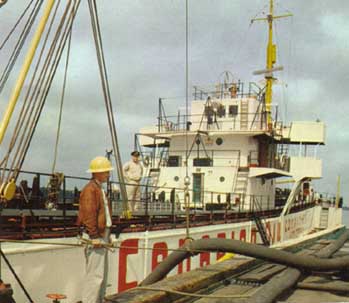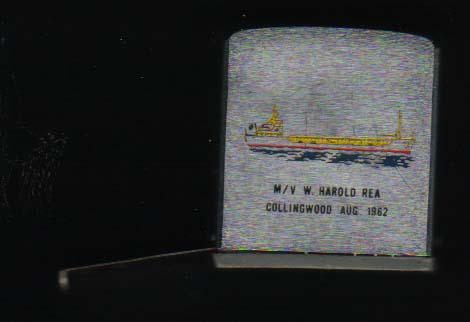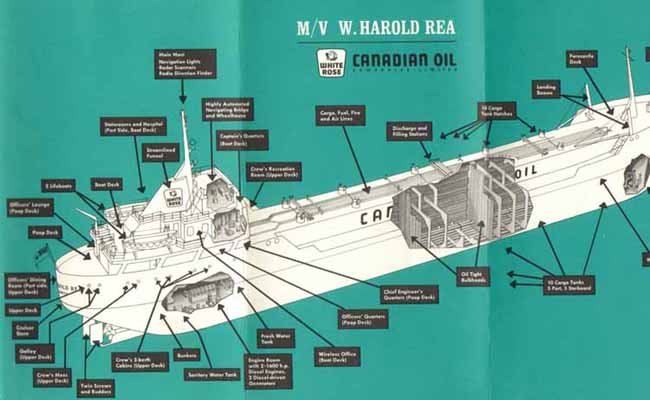 .
.
.
.
 " WHITE ROSE" AHOY !
Monthly Feature
March 2003
...
" WHITE ROSE" AHOY !
Monthly Feature
March 2003
...
Efficient transportation
of crude oil and finished petroleum products presents a
massive and
on-going challenge for the oil industry. While several solutions have
been achieved,
this months "Feature" will concentrate
only on oil tankers / ships.
.....
Stay tuned for future "Features" on other
means of transportation .
....
In 1906 the struggling
Canadian Oil Company purchased an oil tanker which
was christened
the "W.S. Calvert" . Named after
the company president and
local Member of
Parliament, it could carry 7,000
barrels of crude oil, from
Toledo, Ohio to
Froomfield, Ontario
, on the St. Clair River. It was pumped
ashore into
tanks, dug into
the heavy clay on the banks of the
river. The oil was
then carried via
a two-inch pipeline to the Petrolia
refinery 16 miles away.
Two years later,
in 1908, the american National Refining Company acquired
controlling interest in Canadian
Oil Company . Two name changes occurred.
First, the new company name
became Canadian Oil Companies Limited and
the "W.S. Calvert" was
renamed the "En-Ar-Co", a slang, loosely based on
the initials
of the new parent company.
Volume 1, # 6 of
"En-ar-co Booster", dated August 1925, states that during
the 1924 shipping season, the
"En-Ar-Co" made 23 round trips between Toledo
and Froomfield with cargos totaling
156,172 barrels of oil. This publication
referred to the tanker as the
"tank-barge En-Ar-Co".
In 1934 the "En-Ar-Co
was scrapped . I understand that oil was then trans-
ported by the Sarnia - Toledo
Barge Company. I do not know if this was a
subsidiary company or an outside
contractor.
.......
.......
 .......
.......
........
Jump ahead to one
hot summer day in 1944 when the "M.V. (Motor Vessel
to the uninitiated) Eglinton
Park" first hit the water at a Sorel, Quebec, ship-
yard. That was the original
name of the smart new twin screw, diesel engine
tanker which had been built
for the Park Steamship Company. Designed prim-
arily for coastal trade , she
became one of a convoy carrying precious aviation
gasoline from Montreal to Labrador
during the hectic final days of World War
Two. Her first real ocean-going
assignment was carrying a cargo of aviation
gasoline from Curacao in the
Caribbean to West Africa for the British govern-
ment, returning with her tanks
full of palm oil from Lagos, Nigeria. Further
voyages to Mexico and Cuba followed.
In 1945 , while
engaged in coastal trade , something significant occurred to
change the course of the proud
vessels career. With the establishment of marine
terminals at various Great Lakes
ports, the Canadian Oil Companies needed
water-borne transport to link
each of these terminals to the company refinery.
The purchase of the "Eglinton
Park (and renaming it the "John Irwin" in honor
of the Canadian Oil president
at the time) was a natural solution to the problem.
But that didn't
put an end to the ship's deep sea voyaging. At the beginning of
1946, before navigation opened
on the Great Lakes, the "John Irwin", with the
Canadian Oil name and
colours gleaming brightly on hull and funnel, arrived in
Montreal harbor at the end of
a record-breaking trip for a ship of her tonnage.
The tanker , after carrying
a cargo of fuel oil from the trim harbor of Curacao
in the Netherlands West Indies
to the jungle-bound African Gold Coast, took on
3,200 tons of palm oil in familiar
Nigerian waters. Skies were clear and the sea
calm as the "John Irwin" cleared
the African coast on a 5,060 mile haul to
Montreal. Although the vessel
put into the Canary Islands for refueling, she made
the home port in 29 days ---
a very respectable achievement in any sea-going log.
During the navigation
season on the Great Lakes (normally April 1st to about
December 15th) she carried crude
oil ( delivered from the Redwater, Alberta oil -
fields via the Interprovincial
Pipeline ) from Superior, Wisconsin to Sarnia as
well as gasoline and fuel oils
from the Sarnia refinery to marine
terminals at
Cobourg, Windsor, Owen Sound,
Parry Sound, Little Current and
Fort William.
During the winter the vessel,
which now had Sarnia as its port of
registry , was
berthed at that port while intensive
clean-up and paint-up activity
went on in
order to ensure her being shipshape
for the following season on
the Great Lakes.
In 1956 the "John
Irwin" was renamed the M.V."White Rose" , a more fitting
designation for a lady.
........
 .......
.......
M.V. "White Rose" Facts and
Specifications:
Capacity - 945,000 Imperial gals. ( 27,000 barrels)
Draws 18 feet, 7 inches of water loaded
Speed - 10 1/2 knots
Crew - ranged from 22 to 28 man at different times over
the years,
including one woman beginning in 1958
Builder - Marine Industries , Sorel, Quebec
Captain - Captain John A MacIntyre, from the day she was first
commissioned as M.V. Eglinton Park , throughout the
"M.V. John Irwin" era and into the M.V. "White Rose" years.
Sailed - 37,155 miles during 1955
Designed - to the maximum size which could pass through the St. Lawrence
River canals with only inches to spare in both length and beam.
Equipment - Both short and long range radar for safe navigation . Able
to
safely navigate during darkness and fog without fear of collision.
...
....
In
1961 a new tanker was commissioned to supplement the services of the
M.V. "White Rose" . Christened
M.V. "W. Harold Rea", ( in honor of then
president of
the company) she was built to Canadian
Oil Companies specifica-
tions with a
capacity of 51,000 barrels (almost
twice that of M.V."White Rose")
in 10 separate cargo tanks,
600 tons each. She was designed to carry 5 different
White Rose products; 2 grades
of gasoline, domestic, diesel and stove oils with-
out fear of intermixing.
Captain J.A.
MacIntyre assumed skipper duties, while back aboard the
M.V."White Rose" , first mate
Don Kinnear succeeded him as Captain.
....
................. Commemorative Tape Measure
given out at the
christening ceremonies at
Collingwood in 1962.
Commemorative Tape Measure
given out at the
christening ceremonies at
Collingwood in 1962.
M.V. "W. Harold
Rea" Facts and Specifications:
Capacity - 51,000 barrels ,
6,000 tons
Draws
- 21 feet 9 1/2 inches
Speed
- 12 3/4 knots ( approx. 15 MPH)
Length - 355 feet
6 inches
Width - 46
feet
Power - 2
X 1600 diesel engines = 3200 B.H.P.
Crew
- 22 man ( same as M/V "White Rose" in 1962)
Cost
- $2,500,000
Keel laid -
January 11 , 1962
Christened - August 25
, 1962
Builder - Canadian Shipbuilding
and Engineering Co. Ltd., Collingwood, Ont.
Colours - shining white, yellow
and red
In late 1962 Shell Oil
of Canada purchased Canadian Oil Companies Limited.
In 1970 M.V. "W.Harold
Rea" was renamed M.V. "Eastern Shell".
In 1991 she was sold and
renamed M.V. "Lecedre",
In 1993 she was sold to
Panama and again renamed the M.V. "Colon Trader"
...
 ......
Booklet commemorating the launch of M.V.
"W.Harold Rea" August 25, 1962
......
Booklet commemorating the launch of M.V.
"W.Harold Rea" August 25, 1962

...
Click
here to see the latest
Supertest
Monthly Feature.
....
Please Sign my Guestbook----I
want to hear from you!
Sign
My Guestbook View
My Guestbook
...
e-mail--
wpf@mnsi.net
SEE YOU NEXT MONTH !
| En-Ar-Co
/ White Rose | Supertest
Petroleum |
| Daily
Enarcogram |
Brief
Company History
| The
White Rose Story
Boy
and Slate | Logos
| Time
Line | Old
Photos
Monthly
Feature | Past
Features | Gaspumps
| My '36 Ford
Dirty
Rusty Oily Stuff | Oil
Cans | Other
Products
Gasolines
and Globes | Daily
Enarcogam |
Petroliana
Links | Credits
| Buy/Sell/Trade
| About Me
National
Refining Company |
Primary Petroliana
 .
. .
.




